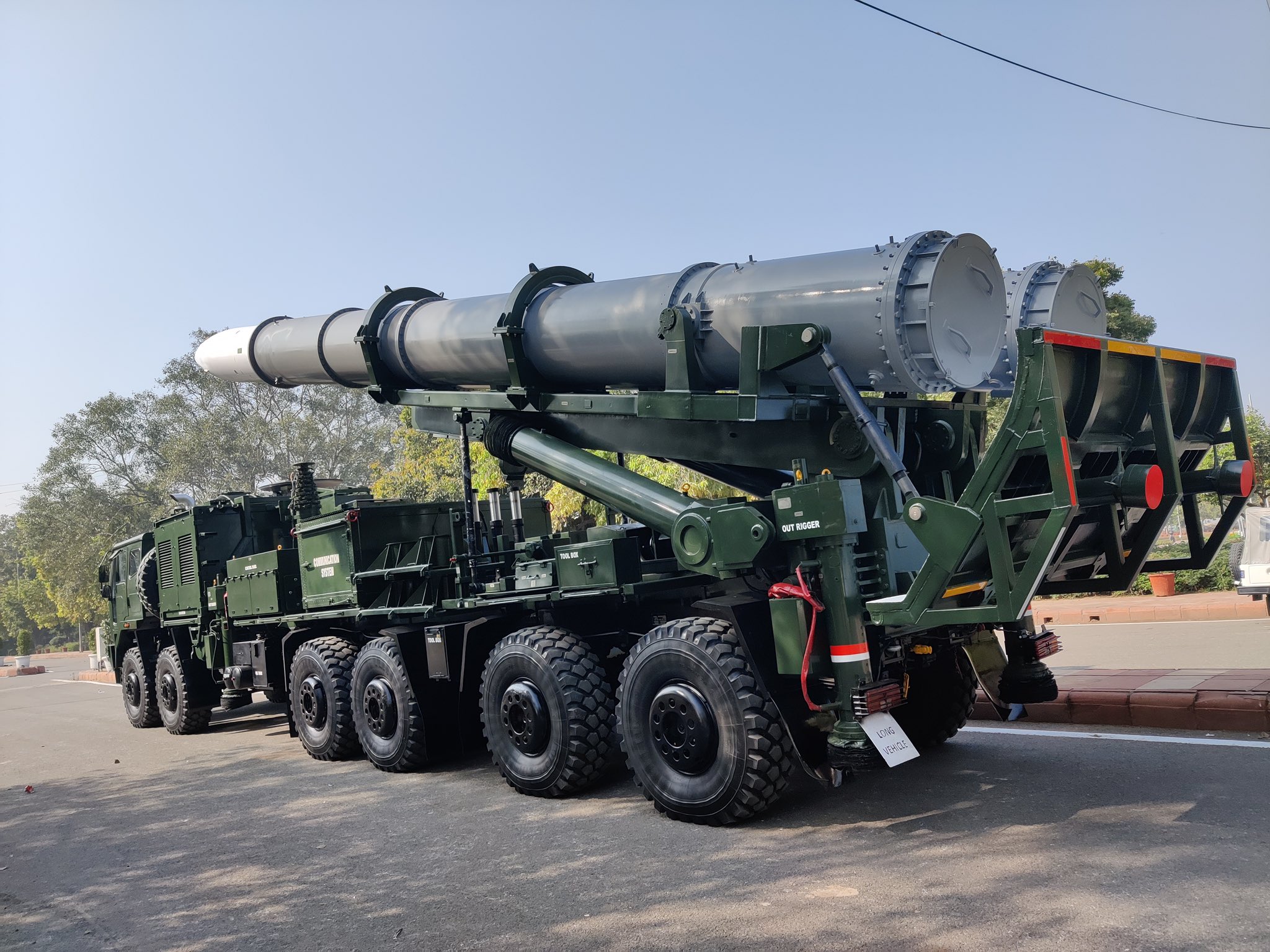SOURCE: RAUNAK KUNDE / NEWS BEAT / IDRW.ORG


The Japanese government has initiated discussions with India to join the joint development of a next-generation fighter jet under the Global Combat Aviation Programme (GCAP), a collaborative effort led by Japan, the United Kingdom, and Italy. According to a government source, Japan aims to reduce the substantial financial burden of the project by expanding the number of participating nations while strengthening security ties with India, a key South Asian power.
The GCAP, a trilateral initiative to design and build an advanced fighter jet to replace aging fleets, involves significant development costs estimated in the billions. By inviting India, Japan hopes to distribute these expenses and leverage India’s growing defense capabilities. Additionally, the move aligns with Japan’s broader strategy to promote stability in the Indo-Pacific region, where India plays a pivotal role.
Continue readingSOURCE: RAUNAK KUNDE / NEWS BEAT / IDRW.ORG


The Indian Army, having already placed initial orders for the indigenously developed Pralay tactical ballistic missile, is now planning to procure additional units to strengthen its strategic capabilities. This decision comes in response to escalating regional tensions with neighboring China and Pakistan, prompting a heightened focus on enhancing the Army’s precision strike capabilities to neutralize critical enemy infrastructure, including command centers and key military installations.
The Pralay missile, developed by the Defence Research and Development Organisation (DRDO), is a quasi-ballistic missile with a range of 150-400 kilometers and a payload capacity of up to 800 kilograms. Its ability to follow a low-altitude, non-linear trajectory makes it difficult to intercept, offering a significant tactical advantage. The missile’s precision and rapid deployment capabilities make it ideal for targeting high-value assets such as enemy headquarters, communication hubs, and logistical nodes in a conflict scenario.
Continue readingSOURCE: AFI


In a brazen display of misinformation, the Directorate General of Public Relations (DGPR) of the Pakistan Air Force (PAF) has released a new propaganda video that falsely showcases India’s BrahMos supersonic cruise missile as a Pakistani weapon. The video, which surfaced recently, has drawn widespread criticism for its deceptive portrayal, further eroding the credibility of DGPR PAF’s media campaigns. This incident adds to a growing pattern of misleading content from the PAF’s public relations wing, raising questions about the ethics of such tactics in a region already fraught with tensions.
Older propaganda video, posted on April 29, 2025, by the official DGPR PAF account on X, was titled “Pakistan Air Force Reaffirms Unwavering Commitment to National Sovereignty & Defence Excellence.” It featured a montage of military assets, including what was presented as a Pakistani missile. However, sharp-eyed observers quickly identified the missile as the BrahMos, a supersonic cruise missile developed through a joint venture between India’s Defence Research and Development Organisation (DRDO) and Russia’s NPO Mashinostroyeniya. The BrahMos, known for its Mach 2.8-3.0 speed and a range of up to 1,500 km in its extended versions, is a flagship of India’s defense capabilities, with no equivalent in Pakistan’s arsenal.
Continue readingSOURCE: AFI


The Indian Army’s Army Design Bureau (ADB), established in 2016 as a catalyst for indigenous defense innovation, is rapidly evolving into a powerhouse of technological advancement, driving the development of cutting-edge military equipment to enhance self-reliance under India’s ‘Aatmanirbhar Bharat’ initiative. Bolstered by the success of the ASMI 9mm submachine gun, designed by a serving soldier, the ADB is now expanding its ambit to develop advanced assault rifles tailored for the Indian Army.
By harnessing the expertise of uniformed engineers and innovators, collaborating with industry and academia, and facilitating Transfer of Technology (ToT) to local production partners, the ADB aims to localize critical defense technologies and enable mass-scale production.
Continue readingSOURCE: AFI


In a significant stride toward self-reliance in defense technology, India showcased its indigenous next-generation autonomous defense systems at the Babina Field Firing Ranges in Uttar Pradesh from April 23 to 25, 2025. The event, highlighted in posts on X, featured cutting-edge innovations aimed at modernizing the Indian Armed Forces and enhancing operational capabilities in diverse combat scenarios. Among the standout technologies displayed were the Sheshnag-150, a long-range swarm drone by Bengaluru-based NewSpace Research and Technologies (NRT), and the Sapper Scout, a multi-utility unmanned ground vehicle (UGV), underscoring India’s growing prowess in autonomous warfare systems.
The Sheshnag-150, developed by NRT, marked a milestone in India’s unmanned aerial capabilities. Named after the mythological serpent, this 150kg unmanned aerial vehicle (UAV) is designed for attritable warfare, focusing on overwhelming adversaries through coordinated swarm attacks. With a range exceeding 1,000 km, an endurance of five hours, and a payload capacity of 25-40 kg, the Sheshnag-150 is engineered for precision strikes deep into enemy territory. Its successful maiden flight, announced by NRT in February 2025, demonstrated its potential as a force multiplier.
Continue readingSOURCE: AFI


A growing rift is said to be emerging within the senior leadership of the Pakistan Army, with several powerful Corps Commanders reportedly at odds with Chief of Army Staff (COAS) General Asim Munir over recent developments related to cross-border operations in Kashmir and his increasingly hardline stance.
Sources familiar with the matter suggest that Lieutenant General Rahat Naseem Ahmed Khan (Commander XII Corps), Lieutenant General Syed Imdad Hussain Shah (XXX Corps), Lieutenant General Saqib Mehmood Malik (XXXI Corps), and Lieutenant General Muhammad Zafar Iqbal (Air Defence Corps) are among the senior commanders expressing strong reservations about Munir’s leadership direction.
Continue readingSOURCE: IDRW.ORG


Since 2019, the Indian Air Force (IAF) has undertaken significant upgrades to its Su-30MKI fleet, integrating advanced beyond-visual-range air-to-air missiles (BVRAAMs) to counter the evolving capabilities of the Pakistan Air Force (PAF). The incorporation of the Israeli I-Derby ER, a short- to long-range missile with a full-sphere launch envelope including the aft hemisphere, and the indigenous Astra missile has brought the IAF’s air combat capabilities closer to parity with the PAF’s BVRAAM arsenal. These enhancements, driven by lessons from the 2019 Balakot skirmish, reflect India’s strategic push to bolster its aerial dominance amid regional tensions.
The February 27, 2019, aerial skirmish following India’s Balakot airstrike exposed critical gaps in the IAF’s air-to-air combat capabilities. During the engagement, PAF F-16s, armed with AIM-120 AMRAAMs (range approximately 100-120 km), forced IAF Su-30MKIs into defensive maneuvers, as the Russian R-77 BVRAAMs (range around 80 km) carried by the Su-30MKIs lacked the reach to effectively counter the PAF jets. The IAF’s Su-30MKIs successfully evaded multiple AMRAAMs but were unable to retaliate offensively due to the range disparity, highlighting the urgent need for longer-range, more capable BVRAAMs.
Continue readingSOURCE: IDRW.ORG


In a significant boost to India’s quest for self-reliance in aerospace technology, Defence Minister Rajnath Singh recently emphasized the urgent need for Indian-made jet engines to power the nation’s fighter jets and unmanned aerial vehicles (UAVs). Speaking at a defense industry conclave in New Delhi on April 30, 2025, Singh announced that the government will allocate additional funds to accelerate the development of the Kaveri engine program, a long-standing initiative led by the Gas Turbine Research Establishment (GTRE) under the Defence Research and Development Organisation (DRDO).
While Singh did not specify whether the funding will support the ongoing Kaveri Derivative Engine (KDE) program—intended to power a 13-ton stealth unmanned combat aerial vehicle (UCAV) named Ghatak—or the proposed Kaveri 2.0 engine targeting 90kN of thrust, his statement has sparked optimism about India’s aerospace ambitions.
Continue readingSOURCE: AFI


In a significant development for India’s defense aviation sector, Hindustan Aeronautics Limited (HAL) has announced that the Advanced Light Helicopter (ALH) Dhruv, in its Army and Air Force versions, has been cleared for operations. This follows a clarification issued on April 11, 2025, and is based on the recommendations of a Defect Investigation (DI) Committee. HAL has also outlined a time-bound plan for the resumption of operations, worked out in collaboration with the Indian Army and Air Force, signaling a resolution to concerns that had previously grounded the helicopter fleet.
The ALH Dhruv, a multi-role helicopter developed by HAL, has been a cornerstone of India’s indigenous defense manufacturing efforts since its first flight in 1992 and induction into service in 2002. Designed to operate in diverse environments—from high-altitude regions like Siachen to maritime roles—the Dhruv is used by the Indian Army, Air Force, Navy, and Coast Guard, with over 300 units delivered as of early 2025. The helicopter has also been exported to countries like Ecuador, Mauritius, and Nepal, showcasing India’s growing defense export capabilities.
Continue readingSOURCE: AFI


In a dramatic turn of events, in new revelations, the Pakistan Air Force (PAF) is grappling with a major shakeup among its top ranks, with two senior officers facing severe repercussions following their involvement in the 2019 Operation Swift Retort. According to a recent screenshot from Military Wiki, out of four key Air Marshals associated with the operation, the third has been jailed, and the fourth has been unceremoniously expelled from the PAF. This leaves only two of the original four still in active service,.
Operation Swift Retort was Pakistan’s military response to India’s airstrike on a Jaish-e-Mohammed (JeM) terrorist camp in Balakot on February 26, 2019, following the Pulwama attack that killed 40 Indian paramilitary personnel. On February 27, the PAF launched a counteroffensive, engaging Indian Air Force (IAF) jets in a dogfight over the Line of Control (LoC). The operation resulted in the downing of an IAF MiG-21, with its pilot, Wing Commander Abhinandan Varthaman, captured and later released. India claimed to have downed a PAF F-16, a claim Pakistan has consistently denied.
Continue readingSOURCE: AFI


In a highly inflammatory post on Facebook, Major General (Retd.) A.L.M. Fazlur Rahman of the Bangladesh Army has called for Bangladesh to invade and occupy India’s seven northeastern states in the event of an Indian attack on Pakistan. Adding to the provocative nature of his statement, Rahman suggested that Bangladesh should initiate discussions with China for joint military actions to achieve this objective. The remarks, which have drawn sharp criticism and raised concerns about regional stability, come at a time of heightened tensions in South Asia.
In his post, Rahman wrote: “If India attacks Pakistan, Bangladesh should invade and occupy India’s seven northeastern states. In my opinion, Bangladesh should start discussions with China for joint military actions in this regard.” The retired general’s comments refer to India’s northeastern region, comprising Assam, Arunachal Pradesh, Manipur, Meghalaya, Mizoram, Nagaland, and Tripura, often referred to as the “Seven Sisters.” These states are connected to the rest of India by the narrow Siliguri Corridor, making the region geopolitically sensitive.
Continue readingSOURCE: AFI


In a significant escalation of tensions between India and Pakistan, India’s issuance of a Notice to Airmen (NOTAM) on April 30, 2025, closing its airspace to all Pakistani-registered, operated, or leased aircraft has laid bare the stark asymmetry in the financial fallout of the ongoing airspace dispute. While India faces minimal losses from its decision, Pakistan’s earlier move to deny Indian flights access to its airspace is costing it dearly—an estimated $300,000 per day—owing to India’s position as the third-largest source of outgoing air traffic globally.
The current crisis began on April 24, 2025, when Pakistan issued a NOTAM closing its airspace to Indian aircraft, following India’s diplomatic offensive in response to the Pahalgam terror attack that killed 26 tourists in Jammu and Kashmir. Pakistan’s closure, set to last until May 25, 2025, disrupted over 70 to 80 daily two-way flights from India to Europe, North America, the Middle East, and Central Asia, forcing Indian carriers like Air India and IndiGo to reroute flights, incur higher fuel costs, and even cancel routes to destinations like Tashkent and Almaty.
Continue readingSOURCE: AFI


The Indian Navy has announced a naval firing exercise scheduled to take place off the coast of Karwar Naval Base in the Arabian Sea on May 7, 2025. The exercise will commence at 08:30 AM IST and conclude at 06:30 PM IST, covering a range of approximately 390km from the base.
According to the Notice to Airmen (NOTAM) issued for the event, the designated firing range extends westward into the Arabian Sea, ensuring a safe distance from the coastline. The exercise is part of routine training operations conducted by the Indian Navy to maintain operational readiness and enhance maritime security capabilities.
Continue readingSOURCE: RAUNAK KUNDE / NEWS BEAT / IDRW.ORG


India’s Defence Research and Development Organisation (DRDO) is poised to redefine aerial combat with the Astra MkIII, christened ‘Gandiva’ after the legendary bow of Arjuna from the Mahabharata. According to sources close to idrw.org, this next-generation beyond-visual-range air-to-air missile (BVRAAM) is designed to achieve a staggering range exceeding 300 km, powered by a cutting-edge solid fuel ducted ramjet (SFDR) propulsion system. With captive trials underway and full-scale production targeted for 2030, the Gandiva is set to elevate the Indian Air Force’s (IAF) capabilities to rival global benchmarks like the MBDA Meteor.
The Astra MkIII ‘Gandiva’ leverages a solid fuel ducted ramjet (SFDR) propulsion system, a technology that uses atmospheric oxygen as an oxidizer, eliminating the need for onboard oxidizers and enabling a lighter, more efficient design. This throttleable ramjet allows the missile to sustain supersonic speeds of up to Mach 4.5 over extended ranges, reportedly reaching 300–350 km under optimal conditions, such as high-altitude launches from 20 km. The SFDR’s ability to modulate thrust mid-flight enhances the missile’s no-escape zone (NEZ), making it highly effective against maneuvering targets, including advanced fighters and high-value assets like AWACS.
Continue readingSOURCE: RAUNAK KUNDE / NEWS BEAT / IDRW.ORG


In a landmark achievement for India’s defense sector, Nagpur-based JSR Dynamics Private Limited has emerged victorious in the Indian Navy Open Challenge 8.0, securing a contract to develop a cutting-edge Long Range Powered Precision Guidance Munition (LRPGM). The company recently revealed the specifications and design of this advanced weapon system, marking a significant step toward enhancing the Indian Navy’s precision strike capabilities. This development underscores India’s growing prowess in indigenous defense technology amid heightened regional tensions, particularly following its withdrawal from the Indus Waters Treaty (IWT) in 2025.
JSR Dynamics, a private firm specializing in defense and aerospace solutions, won the Indian Navy’s Open Challenge 8.0, a competitive initiative aimed at fostering innovation in military technology. The LRPGM project aligns with India’s broader push for self-reliance in defense manufacturing under the Atmanirbhar Bharat initiative. The company’s success highlights the increasing role of private players in bolstering India’s military capabilities, especially as the nation navigates complex geopolitical challenges with neighbors like Pakistan and China.
Continue reading